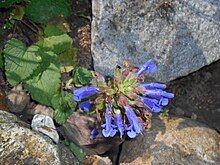| Dracocephalum rupestre | |
|---|---|

| |
| Scientific classification | |
| Kingdom: | Plantae |
| Clade: | Tracheophytes |
| Clade: | Angiosperms |
| Clade: | Eudicots |
| Clade: | Asterids |
| Order: | Lamiales |
| Family: | Lamiaceae |
| Genus: | Dracocephalum |
| Species: | D. rupestre
|
| Binomial name | |
| Dracocephalum rupestre | |
Dracocephalum rupestre is a plant species in the genus Dracocephalum, endemic to China.[2][3] The specific epithet, "rupestre", is derived from Latin, and pertains to the plant growing among rocks.[citation needed]

Description[edit]
Dracocephalum rupestre is a rhizomatous herb having numerous purplish, upwards-rising and unbranching stems (15–42 cm) scantily covered in backward-pointing hairs. Triangular-ovate, sparsely villous leaves (1.4–5.5 × 1.2–4.5 cm) are numerous. Inflorescences are verticillastrate with bluish-purple petalled flowers.[4] Flowering period is from July–September.[4]
Habitat and distribution[edit]
The habitats of Dracocephalum rupestre are mountain meadows and slopes, or areas of thinning forest where more sun reaches the surface, at elevations between 700 and 3100 meters.[4] They are native to China; occurring in Hebei, Inner Mongolia, Liaoning, Qinghai, and Shanxi provinces.[4][5]
Uses[edit]
People in Hebei and Shanxi have used Dracocephalum rupestre as a tea substitute, and in gardens for their showy flowers.[4]
References[edit]
- ^ Dracocephalum rupestre was originally described and published in Journal of Botany, British and Foreign 7(79): 166. 1869. "Name - Dracocephalum rupestre Hance". Tropicos. Saint Louis, Missouri: Missouri Botanical Garden. Retrieved November 16, 2012.
- ^ "Plants of the World Online | Kew Science". Plants of the World Online. Retrieved 2023-10-12.
- ^ "Dracocephalum rupestre in Flora of China @ efloras.org". www.efloras.org. Retrieved 2023-10-12.
- ^ a b c d e "Dracocephalum rupestre Hance in Lamiaceae, Dracocephalum". Flora of China. 17. eFloras: 132. Retrieved November 16, 2012.
- ^ "Name - Dracocephalum rupestre distribution". Tropicos. Saint Louis, Missouri: Missouri Botanical Garden. Retrieved November 16, 2012.
External links[edit]
- detailed b/w illustration from mobot.org